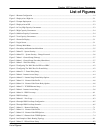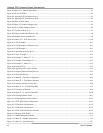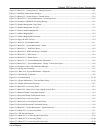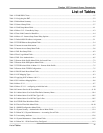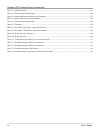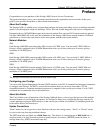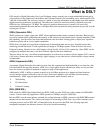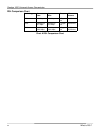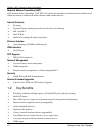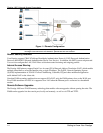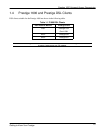
Prestige 1600 Universal Access Concentrator
Quick Reference
xix
What is DSL?
DSL stands for Digital Subscriber Line. Local Exchange carriers currently use a single unshielded twisted pair of
wire on the local loop (between Central Office and Customer Premises) for transmitting voice, which requires 300-
3,400 Hz of bandwidth. The wires are, however, capable of carrying information at much higher rate when modern
digital processing techniques are deployed. The same pair of wires are used successfully worldwide to provide
ISDN services yielding up to 128 Kbps. The explosive growth in Internet access, remote LAN access and
telecommuting demand data rates that are a lot higher than what conventional analog modems can provide over the
existing pair of wires.
SDSL (Symmetric DSL)
SDSL operates on a single copper pair. SDSL allows applications that require symmetric data rates. Because only
one pair is needed in this arrangement, the capacity of the entire local loop infrastructure is greatly magnified. With
this capability, local providers can extract the maximum value from their existing plant, or deploy new capacities
both more quickly and at a lower capital expenditure.
SDSL allows for rapid and cost effective deployment of intermediate data rate services. Potential uses for this
technology include fractional T1 with a particular advantage in 768 Kbps systems, Work-at-home LAN access,
Distance Learning, Internet Access, and Campus or Large Facility LAN to LAN connectivity. Since SDSL can be
configured at multiple data rates, it can have different capacity and reach limitations.
This also allows for easy, cost-effective implementation of such services as remote cell site support of PCs, remote
LAN access, distance education and training, digital imaging, or any other service, which requires a larger amount
of bandwidth.
ADSL (Asymmetric DSL)
Asymmetric Digital Subscriber Line takes its name from the comparatively high bandwidth in one direction, with
low bandwidth in the opposite direction. ADSL uses a single phone line for transmission. Many service providers
have also come to recognize its potential to support a range of data applications.
Additionally, ADSL’s ability to operate at speeds of up to 8 Mbps positions it to support real-time broadcast
services and pre-recorded interactive video services; and to have multiple video and data activities running
simultaneously. ADSL supports applications with asymmetric traffic demands such as:
! Web Surfing
! File Downloads
! Distance Learning
IDSL (ISDN DSL)
IDSL stands for ISDN Digital Subscriber Line (IDSL). IDSL uses the 2B1Q line coding standard for ISDN BRI
circuits. Used for data-only applications, IDSL operates at 128 Kbps for up to 18,000 feet.
Because IDSL uses the same industry-standard line coding technique as ISDN, customers with ISDN BRI terminal
adapters can use their current TAs, routers and bridges for connecting to IDSL lines. Any of the commonly used
transport protocols such as PPP, MP, or Frame Relay may be used over the IDSL line, allowing rapid and
transparent integration into Internet, remote LAN access and telecommuting.



